-
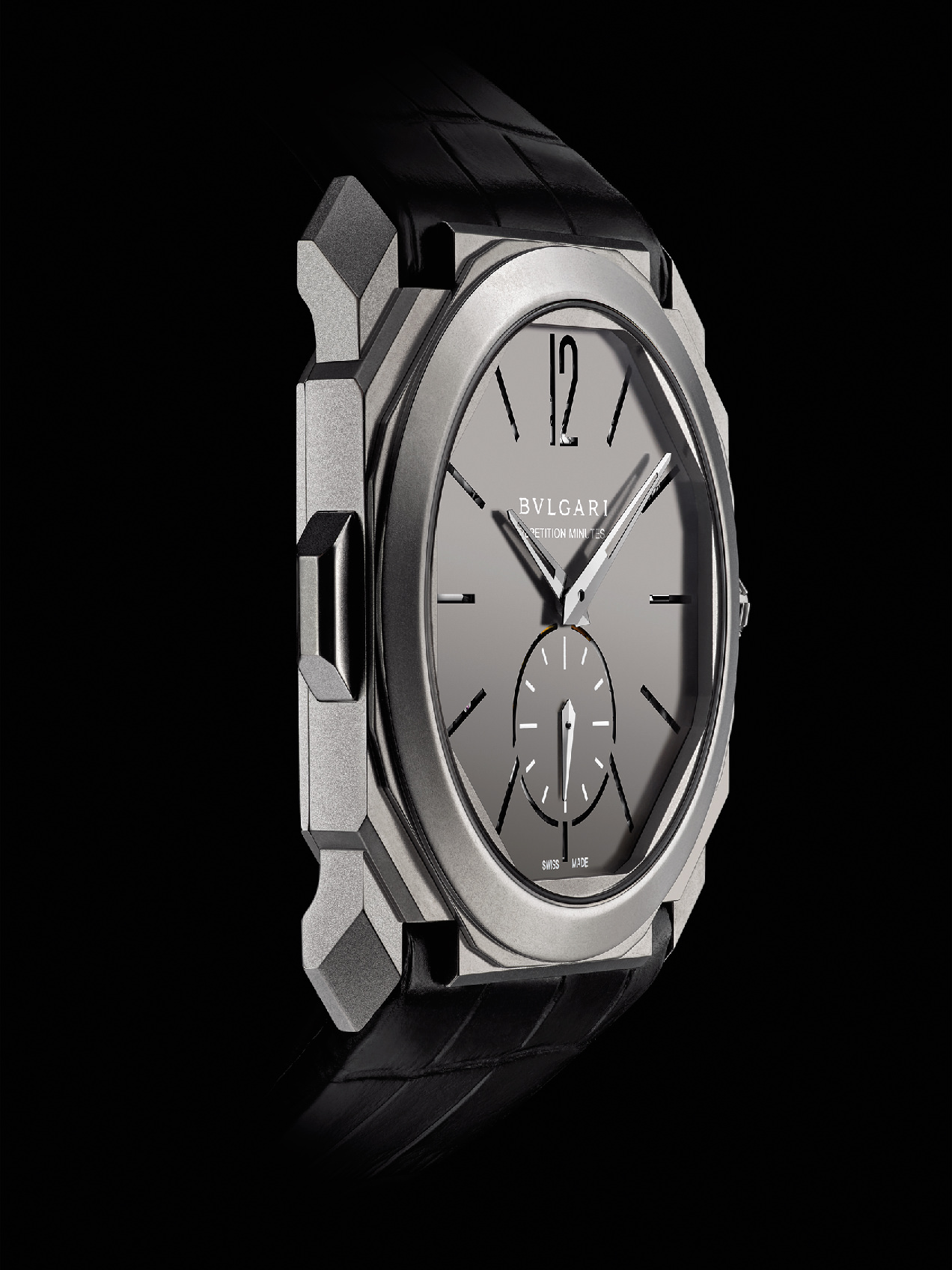
Bulgari Octo Finissimo Minute Repeater, the world’s current thinnest minute repeater, is only 6.85 mm thick.
-
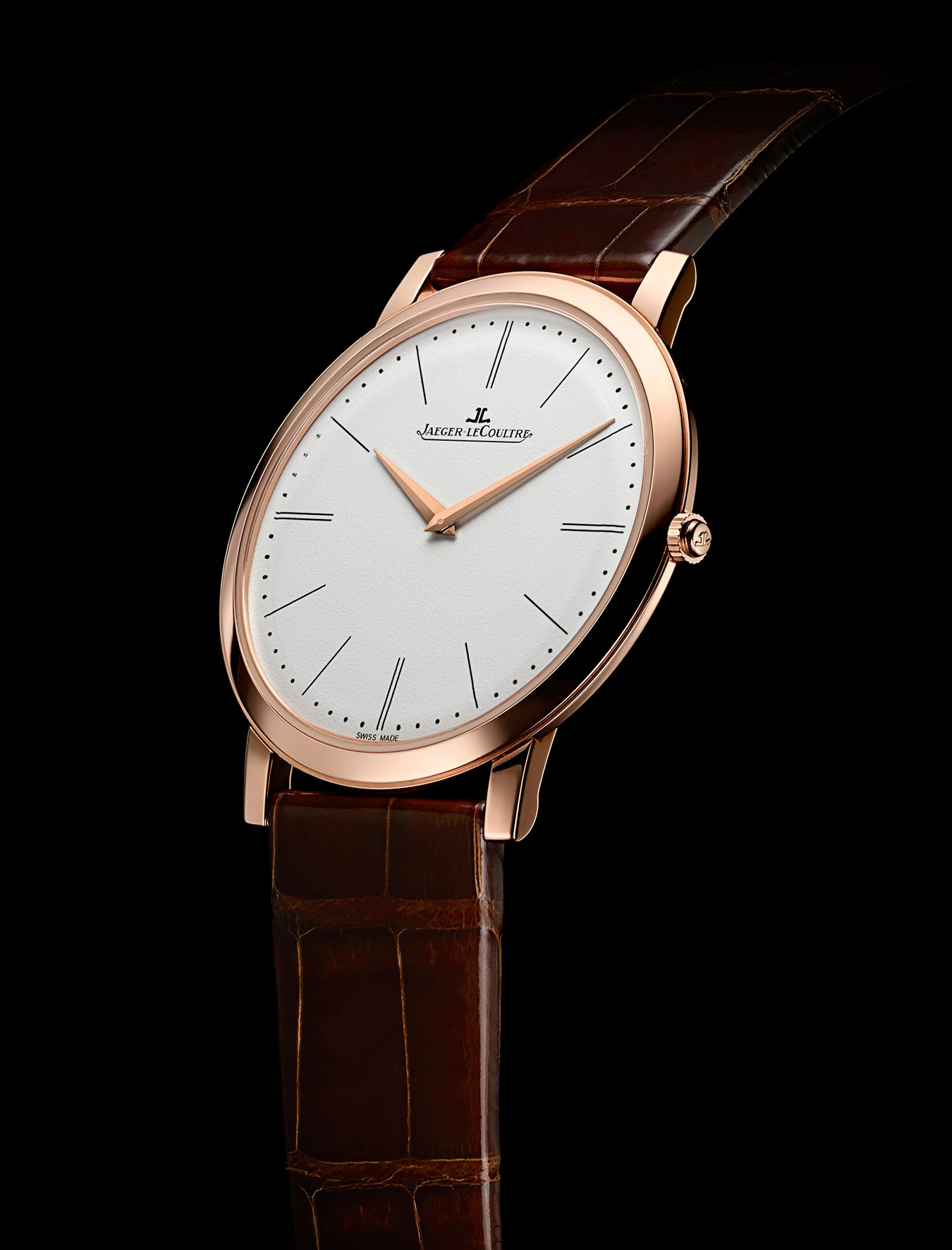
Jaeger-LeCoultre boasts an outstanding legacy in ultra-thin watchmaking. Here, the Master Ultra Thin 1907.
-
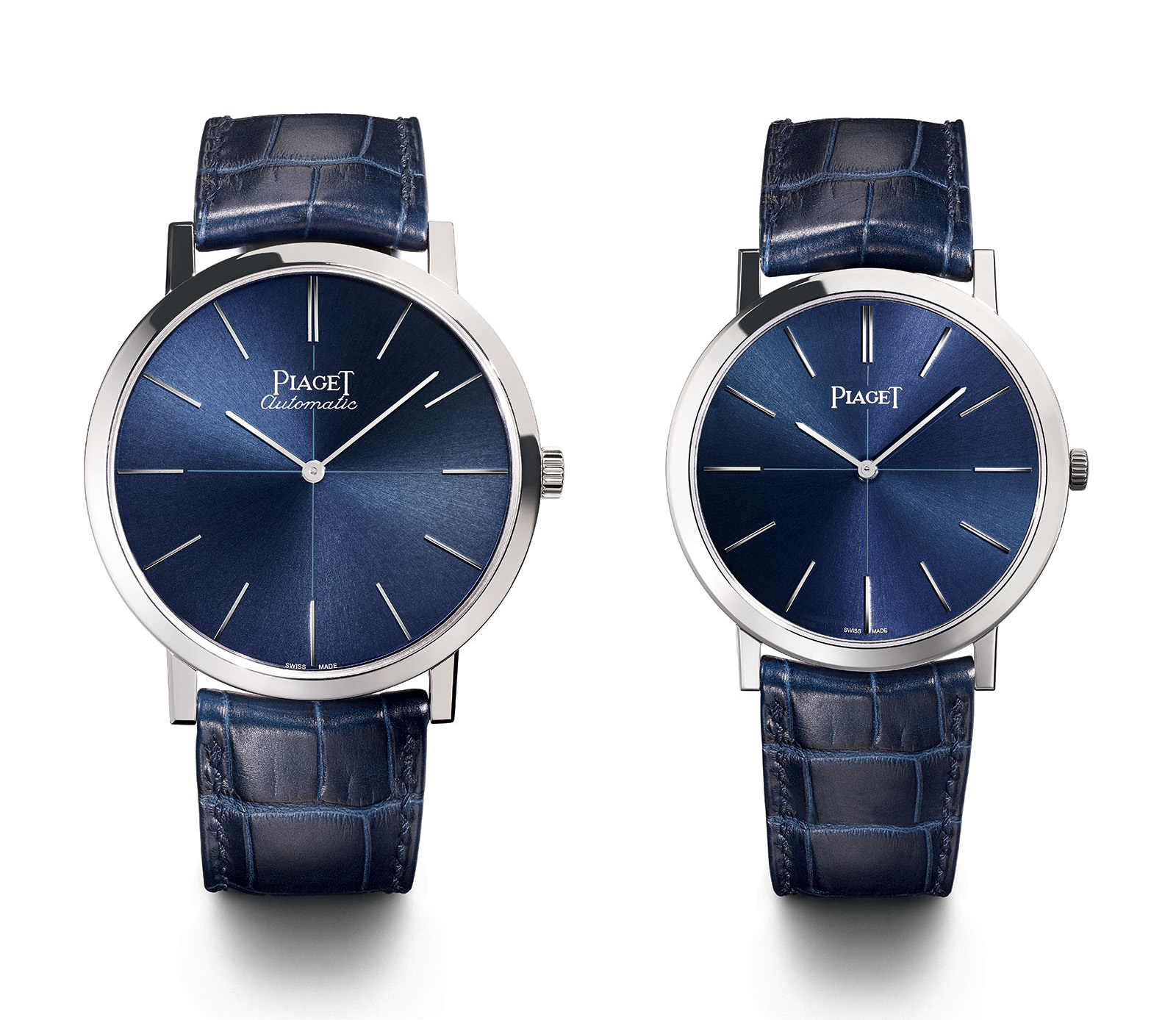
Piaget marks the Altiplano’s 60th anniversary with limited edition timepieces. The Altiplano Self-Winding 43 mm and the Altiplano Manual-Winding 38 mm are distinguished by sunburst dials in Piaget blue.
-

Patek Philippe Ref. 5140P perpetual calendar based on its ultra-thin mechanical self-winding movement in platinum.
-

Vacheron Constantin Overseas Ultra-Thin Perpetual Calendar powered by the automatic Calibre 1120 QP and measuring 4.05 mm thick.
-
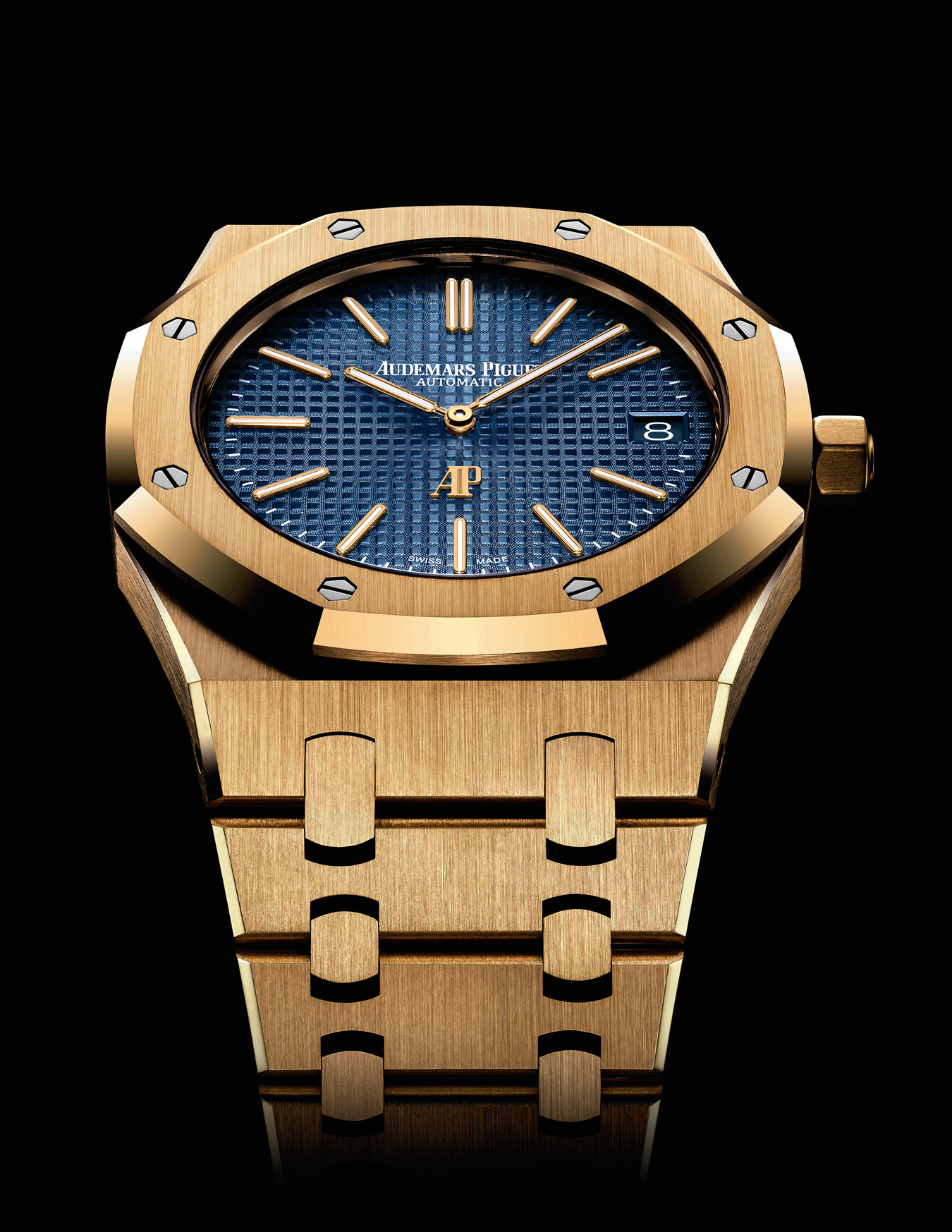
Audemars Piguet’s Royal Oak Extra-Thin in yellow gold revives a flagship model from 1977.
Ultra-Thin Watches for Men
Understated yet stately.

Vacheron Constantin Overseas Ultra-Thin Perpetual Calendar powered by the automatic Calibre 1120 QP and measuring 4.05 mm thick.
Considering that a watch is essentially a miniature clock, miniaturization has been a pursuit of watchmakers since the very beginning. Around the year 1500, table clocks paved the way for the first pocket watches. Significant technical advancements over the ensuing centuries turned pocket watches into ever-slimmer devices and eventually into svelte wristwatches. By the mid-20th century, masters of the art had managed to pare down movements to coin-like dimensions, producing sleek, elegant wristwatches that posed daunting technical challenges, as it is far more difficult to produce a thin movement, particularly with complications, than a thicker one.
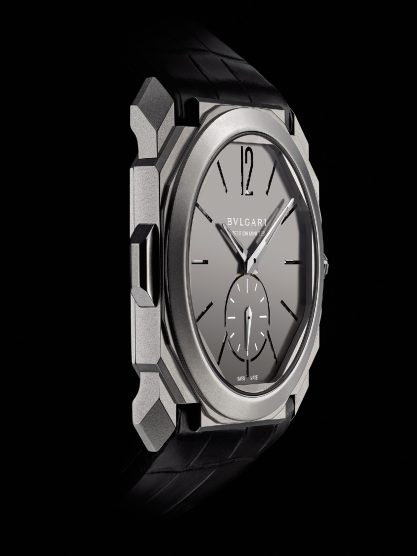
Bulgari Octo Finissimo Minute Repeater, the world’s current thinnest minute repeater, is only 6.85 mm thick.
The dividing line between the two is not a matter of mere dimensions, points out Michael Friedman, historian at Audemars Piguet. He explains that it’s more about the way a watchmaker consciously designs a watch to be thinner. Telltale engineering clues, such as the lack of a second hand, indicate that a watch was built to be as thin as possible.
One of Audemars Piguet’s claims to ultra-thin fame is the Reference 25643, an automatic tourbillon featuring the Calibre 2870. At only 4.8 mm thick, it was once the thinnest automatic tourbillon ever made. Even more impressive, it debuted in 1986, before modern technology could aid watchmakers in cutting-edge movement design and production. The brand’s flagship Royal Oak, which launched in 1972, was another slender benchmark. This year’s Royal Oak Extra-Thin in yellow gold revives a design from 1977, while the Royal Oak Tourbillon Extra-Thin Openworked is now available in pink gold and stainless steel.
Reviewing records from Audemars Piguet’s vast archives, Friedman traces the evolution of ultra-thin watchmaking through the ages noting milestones, such as the game-changing late-18th-century movement by French watchmaker Jean-Antoine Lépine, whose vision triggered a shift from the orb-like pocket watches of the day to thinner timepieces that paralleled changing fashion trends. Friedman asserts that all modern watchmaking is built on the Lépine calibre. After the turn of the 20th century, watchmakers were competing to produce the thinnest movements at a time when wristwatches were emerging and would soon dominate.
By the mid-20th century, masters of the art had managed to pare down movements to coin-like dimensions, producing sleek, elegant wristwatches that posed daunting technical challenges.
In 1907, Jaeger-LeCoultre, which boasts an outstanding legacy in ultra-thin watchmaking, produced a pocket watch powered by the record-breaking 1.38-mm-thick Jaeger-LeCoultre Calibre 145, which remains the thinnest movement in its category. A second notable Knife pocket watch from 1930 exudes the sleek and streamlined curves of the art deco aesthetic of the era, another culture driver of the slim watch. Jaeger-LeCoultre has continued to build on this heritage with an ever-growing range of ultra-thin watches. In 2014, the Master Ultra Thin 1907 paid tribute to that original pocket watch. Engineers sought to shave precious millimetres at every step of development, resulting in the manually wound Calibre 849, measuring 1.85 mm thick. The Master Ultra Thin collection has also expanded with complications, such as last year’s Master Ultra Thin Perpetual, with a handsome black dial. And in 2015, Jaeger-LeCoultre laid claim to the world’s thinnest mechanical watch with the Master Ultra Thin Squelette, a skeletonized version of the Master Ultra Thin 1907 measuring 3.60 mm thick.

Jaeger-LeCoultre boasts an outstanding legacy in ultra-thin watchmaking. Here, the Master Ultra Thin 1907.
Piaget’s Altiplano 900P from 2014 previously held the thinnest mechanical watch record with an ingenious condensed architecture that uses the caseback as the movement’s main plate and places the hands off-centre to reduce height. A pioneer in ultra-thin watchmaking, Piaget introduced its revolutionary Altiplano in 1957, powered by the unprecedented 2-mm-thick manually wound 9P movement. It followed up the achievement three years later with the self-winding 12P movement at only 2.3 mm thick, thanks to the use of an off-centre microrotor.
This year, Piaget marks Altiplano’s 60th anniversary with a full range, including limited editions that pay tribute to those mid-century originals. The Altiplano Self-Winding 43 mm and the Altiplano Manual-Winding 38 mm are distinguished by sunburst dials in Piaget blue, a retro shade between cobalt and midnight. The dial displays the brand’s vintage logo, and historic crosshair design, slender applied white gold hour markers, and slim baton hands. Just as the aesthetic stays true to the codes of the first Altiplanos, the automatic Calibre 1200P (2.35 mm) and the manual Calibre 430P (2.1 mm) are also worthy descendants of their groundbreaking forebears.

Piaget marks the Altiplano’s 60th anniversary with limited edition timepieces. The Altiplano Self-Winding 43 mm and the Altiplano Manual-Winding 38 mm are distinguished by sunburst dials in Piaget blue.
Because the specialty is so technically demanding, ultra-thin watches typically come from prestigious old-guard maisons. Building on their long, illustrious histories, Vacheron Constantin and Patek Philippe also have bragging rights in ultra-thin watchmaking.
Last year, Vacheron Constantin rebooted its Overseas sport watch collection with a redesigned range that included an Ultra-Thin Perpetual Calendar powered by the automatic Calibre 1120 QP and measuring 4.05 mm thick. And last year, Patek Philippe introduced the Ref. 5140P perpetual calendar, based on its ultra-thin 240 Calibre movement with the addition of a perpetual calendar function.
Because the specialty is so technically demanding, ultra-thin watches typically come from prestigious old-guard maisons.
Given that prowess in ultra-thin watchmaking has traditionally been achieved by only the most established and prestigious watch brands, observers raised a collective eyebrow in 2013 when Arnold & Son, a modern reincarnation of an old English marque, unveiled its UTTE tourbillon and claimed the record for the thinnest tourbillon on the market with a case measuring 8.34 mm. Last year, Arnold’s UTTE Skeleton, with the same case dimensions, became the thinnest skeleton tourbillon.
The UTTE’s reign as thinnest tourbillon was brief. Bulgari, another rising star in thin watchmaking, introduced its Octo Finissimo Tourbillon in 2014, with a 1.95-mm movement housed in a compact 5-mm faceted case. Bulgari was quick to follow up last year with the Octo Finissimo Minute Repeater, the world’s thinnest minute repeater, with a striking contemporary design that brought the typically classic and traditional minute repeater into the modern age. “The idea was to remove the dusty look of minute repeaters that are expressions of an old-fashioned way,” says Guido Terreni, managing director of Bulgari Watches.

Audemars Piguet’s Royal Oak Extra-Thin in yellow gold revives a flagship model from 1977.
Bulgari’s ability to build such a remarkable piece owes a debt to the long-standing technical expertise of the Gérald Genta and Daniel Roth brands, which it acquired in 2000. “Ultra-thin is a new skill that grew internally, thanks to the Finissimo projects,” adds Terreni, who saw the segment as an opportunity and focused the brand’s in-house expertise on developing it.
Have we finally reached the limit for how thin a mechanical watch can be? “Thinness has always been a part of technology. Look at our monitors, our screens—everything is about slimming down the profile so it almost disappears,” explains Friedman. “Watches are central to the history of science and technology, and they too have been subject to that same pursuit of thinness and miniaturization.” In modern watchmaking, the emphasis has been on thinness rather than miniaturization, as in previous centuries. “You don’t see companies pursuing that line of research as much as we have in previous generations,” he adds. “But that could change again.”
_________
Never miss a story. Sign up for NUVO’s weekly newsletter.




